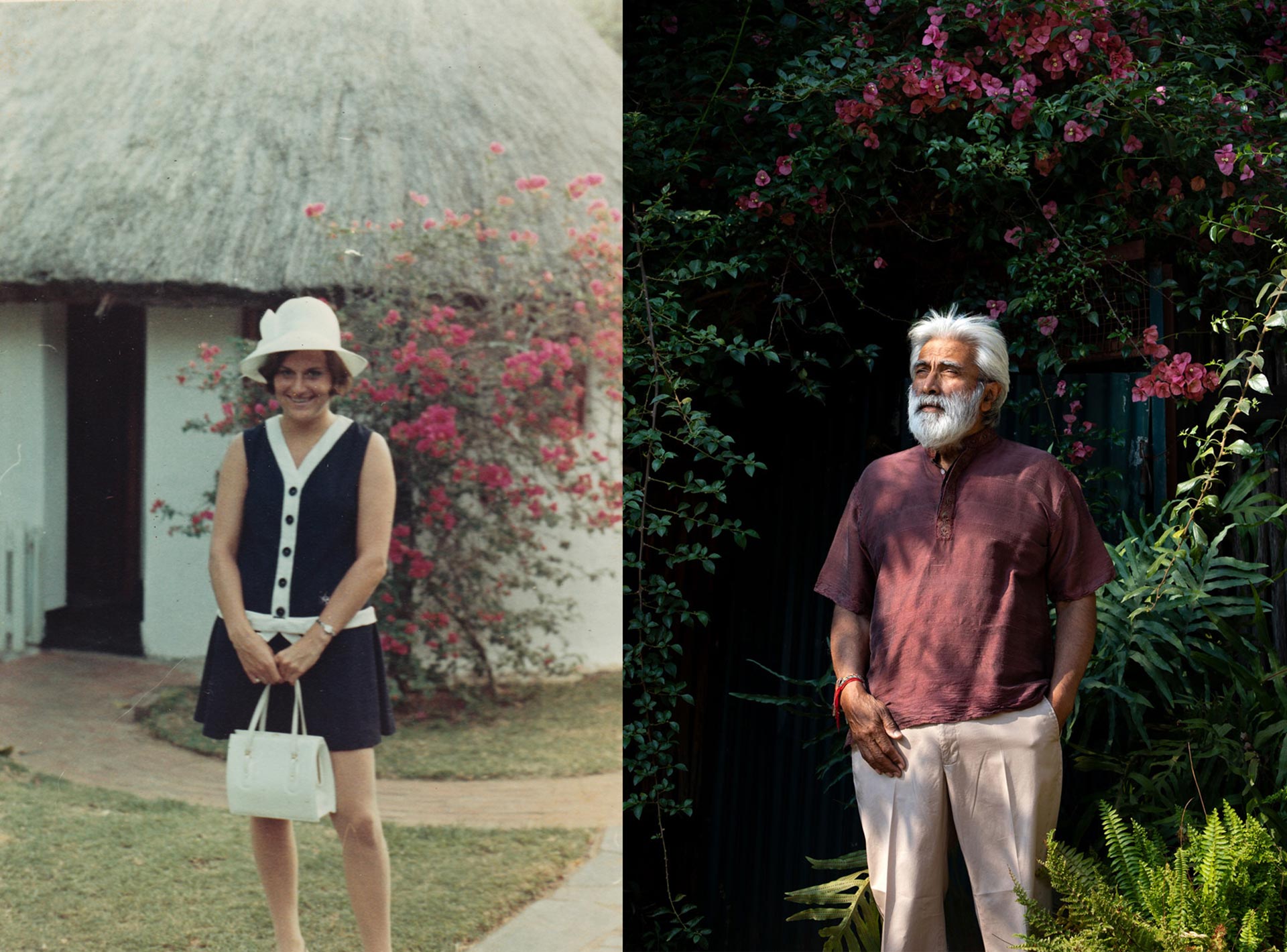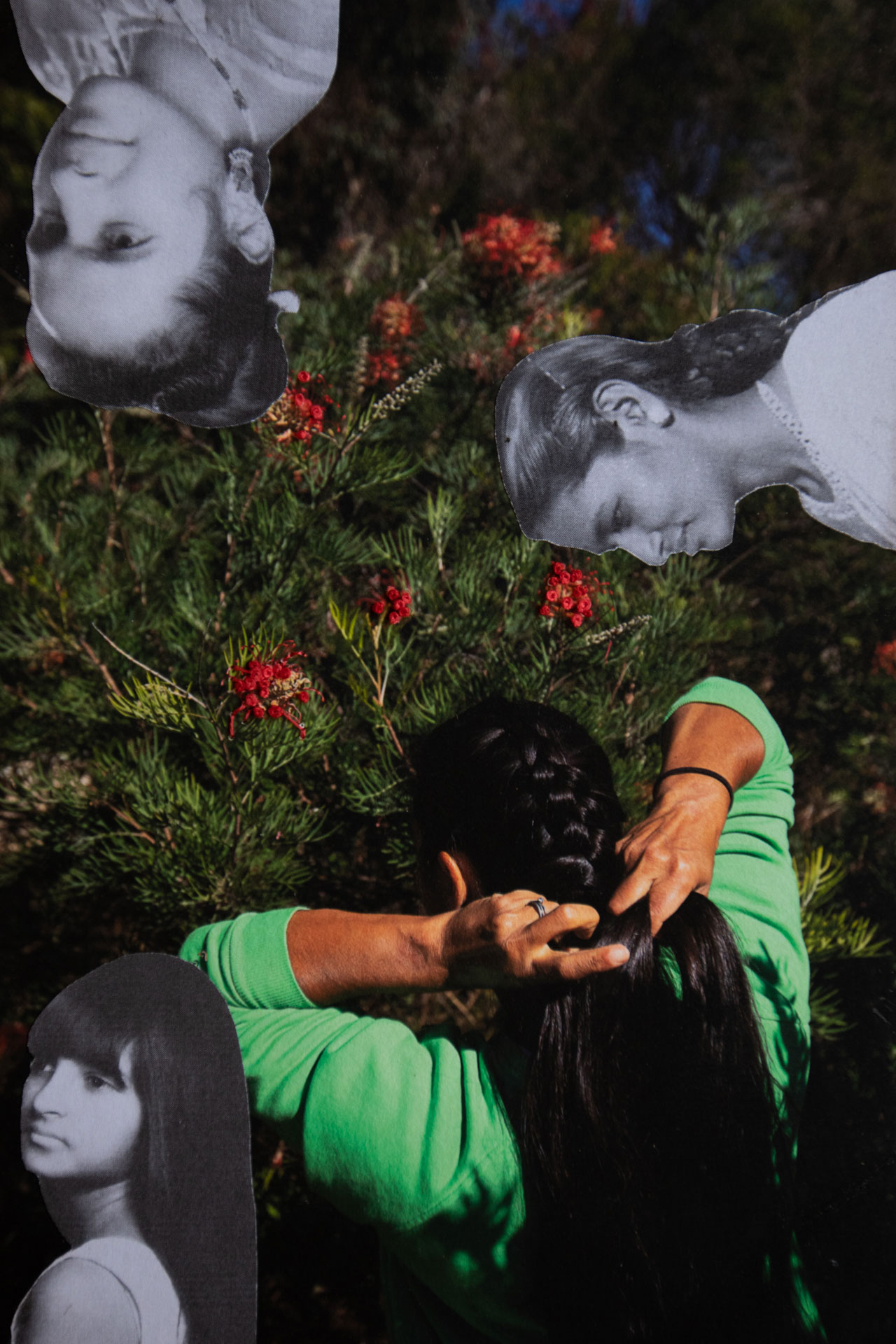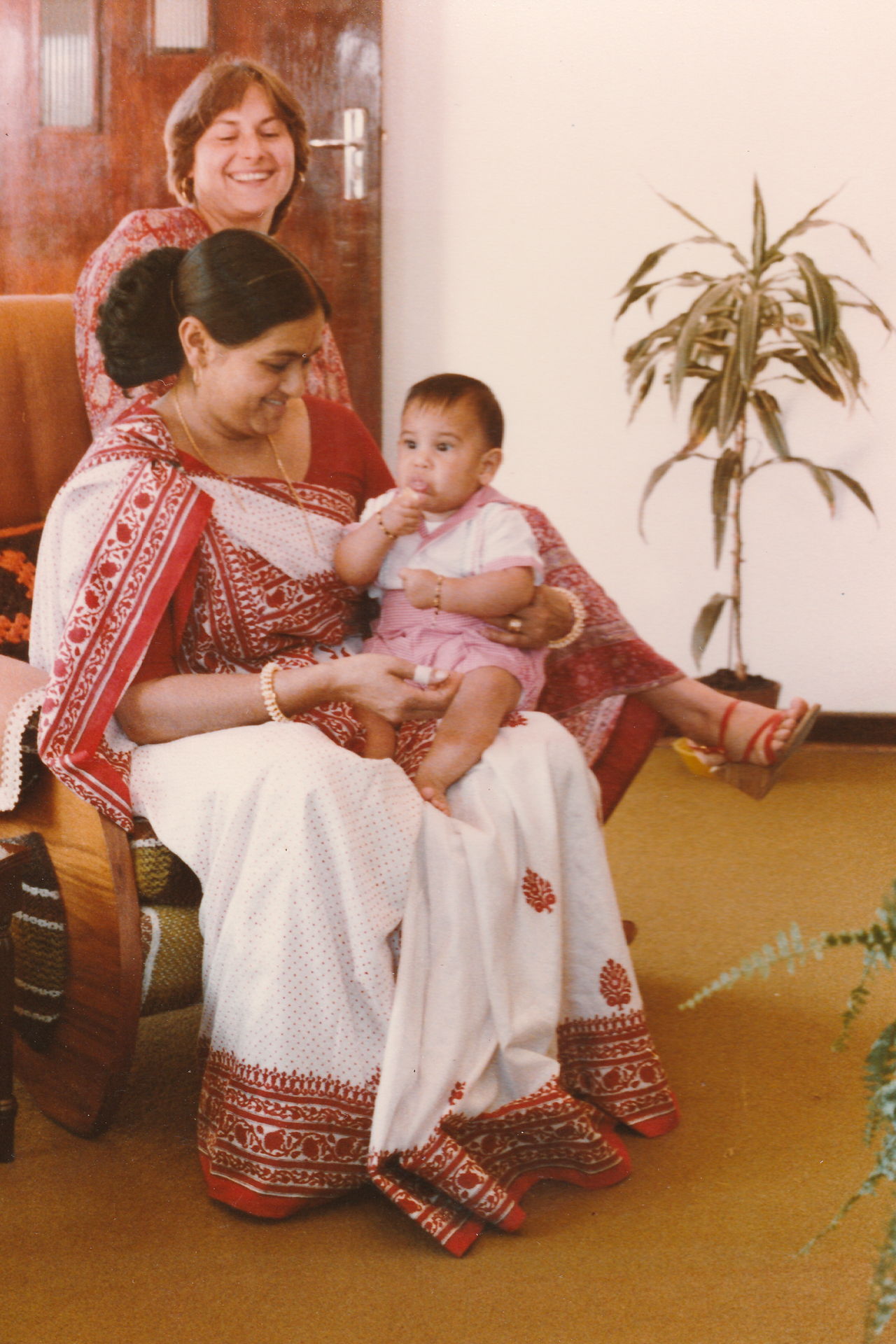The Landscape Does Not Sit Willingly
The Landscape Does Not Sit Willingly is a visual interrogation of my hybrid cultural identity, which explores the connection between conventional family photography and concepts of belonging.
I am a child of tangled colonial histories, a fourth generation Zimbabwean of Indian origin on my father’s side, with Dutch and German ancestry via South Africa on my maternal side. As a citizen of Zimbabwe, I identify as African and by virtue of my marriage to an Australian, I am now an immigrant on the opposite side of the Indian Ocean looking back at one ‘home’ from the viewpoint of another.
This ongoing series, ‘The Landscape Does Not Sit Willingly’, evokes Tim Ingold’s anthropological concept of meshworks in which “every living being is a bundle of lines” that tangles with others[1]. The bold portraits incorporate elements of the natural environment, especially ‘native’ and ‘invasive’ species as a metaphor for belonging, layering archival images and African wax print embellishments, juxtaposing past and present, and creating something new from the entanglement.
The work plays with ambiguity, challenging at once the objective truth of photography and history and suggesting that as we search for a sense of belonging, hope can be found in the act of ‘becoming’. Like the condition of hybridity itself, the series contains a selection of single images, diptychs, and embroidered images taken from documentary photographs of my family and homes in Zimbabwe and Australia.
The series title is from a Kei Miller poem, ‘What the Mapmaker Ought to Know’, 2015.
“On this island
Things fidget
Even history
The Landscape Does Not Sit
Willingly.”
[1] Tim Ingold The Life of Lines (London and New York: Routledge, 2015)
 'Pride of India'. Self-portrait in my wedding dress, Bridgetown, Western Australia, ongoing (Embroidered Photographic Collage)
'Pride of India'. Self-portrait in my wedding dress, Bridgetown, Western Australia, ongoing (Embroidered Photographic Collage)
 'Notes for 1974'. A diary belonging to my uncle, Arvind Patel, recording visits and immigration of family members from India to Southern Rhodesia, 2022.
'Notes for 1974'. A diary belonging to my uncle, Arvind Patel, recording visits and immigration of family members from India to Southern Rhodesia, 2022.
 'Natural Hybrids'. My parents and the bougainvillea in Stanger, (now known by its original Zulu name, KwaDakuza), South Africa, 1970s, and at home in Harare (formerly known as Salisbury, at the time my parents met), Zimbabwe, 2022. (Diptych)
'Natural Hybrids'. My parents and the bougainvillea in Stanger, (now known by its original Zulu name, KwaDakuza), South Africa, 1970s, and at home in Harare (formerly known as Salisbury, at the time my parents met), Zimbabwe, 2022. (Diptych)
 'Untitled', Dying orchid flowers like on the verandah of my family home in Harare. My father has always been a keen orchid and fuschia grower, 2022.
'Untitled', Dying orchid flowers like on the verandah of my family home in Harare. My father has always been a keen orchid and fuschia grower, 2022.
 'Bilateral Symmetry', My brother, Asa, and I on our the same verandah approximately 37 years apart, surrounded by our father's flower collection, 2022. (Diptych)
'Bilateral Symmetry', My brother, Asa, and I on our the same verandah approximately 37 years apart, surrounded by our father's flower collection, 2022. (Diptych)
 ‘Jogi Buildings, 1937’ This store was built by my great-grandfather on the main street in Shurugwi, Zimbabwe. It still bears his name nearly 90 years later, though instead of the shop it once held, is now the Shamwari Dzakanaka Cocktail Bar, providing a recreation space for the thousands of small-scale miners (known as makorokoza) that have flocked to find Shurugwi’s gold, 2022.
‘Jogi Buildings, 1937’ This store was built by my great-grandfather on the main street in Shurugwi, Zimbabwe. It still bears his name nearly 90 years later, though instead of the shop it once held, is now the Shamwari Dzakanaka Cocktail Bar, providing a recreation space for the thousands of small-scale miners (known as makorokoza) that have flocked to find Shurugwi’s gold, 2022.
 'This Black Earth', Portrait of my father, Shasekant Jogi, at a site for a housing development he worked on, near our home in Harare, Zimbabwe. Born in Southern Rhodesia in 1947, he has spent the majority of his life as an urban planner dedicated to developing the built environment in what became independent Zimbabwe. Despite his Indian heritage, he has never set foot on the subcontinent. The burnt earth is all that remains of his grandfather’s market garden in Shurugwi, over a century later, 2022. (Diptych)
'This Black Earth', Portrait of my father, Shasekant Jogi, at a site for a housing development he worked on, near our home in Harare, Zimbabwe. Born in Southern Rhodesia in 1947, he has spent the majority of his life as an urban planner dedicated to developing the built environment in what became independent Zimbabwe. Despite his Indian heritage, he has never set foot on the subcontinent. The burnt earth is all that remains of his grandfather’s market garden in Shurugwi, over a century later, 2022. (Diptych)
 'Brown Gilt', Self-portrait with the golden wattle, Bridgtown, Western Australia, ongoing. (Embroidered Photographic Collage)
'Brown Gilt', Self-portrait with the golden wattle, Bridgtown, Western Australia, ongoing. (Embroidered Photographic Collage)
 'Convergent Evolution', My great-grandfather, Govan Jogi, established himself in Shurugwi in the early 1900s. He travelled from Surat, India to the coast of Mozambique and then walked into the interior of the continent searching for better opportunities, ending up in Southern Rhodesia’s gold fields. Today, the only descendent remaining in the area is my dad's cousin, Ella Patel, who lives with her husband above the shop his family owned in nearby Gweru. The copper Australia clock hangs in one of the bedrooms though Ella had no idea where it had come from, 2022 (Diptych)
'Convergent Evolution', My great-grandfather, Govan Jogi, established himself in Shurugwi in the early 1900s. He travelled from Surat, India to the coast of Mozambique and then walked into the interior of the continent searching for better opportunities, ending up in Southern Rhodesia’s gold fields. Today, the only descendent remaining in the area is my dad's cousin, Ella Patel, who lives with her husband above the shop his family owned in nearby Gweru. The copper Australia clock hangs in one of the bedrooms though Ella had no idea where it had come from, 2022 (Diptych)
 My husband, Steven Dean, is pictured among Jarrah and Xanthorrhoea grasstrees, known as Balga, in a conservation area bordering our home. Balga may be interpreted as “one that is connected to” in the indigenous Noongar language of southwest Western Australia. Born and raised in Sydney, Steven lived in the Middle East and Africa before settling in Western Australia. He has now driven our return to live in Zimbabwe, the only place he says he really felt at home, 2022
My husband, Steven Dean, is pictured among Jarrah and Xanthorrhoea grasstrees, known as Balga, in a conservation area bordering our home. Balga may be interpreted as “one that is connected to” in the indigenous Noongar language of southwest Western Australia. Born and raised in Sydney, Steven lived in the Middle East and Africa before settling in Western Australia. He has now driven our return to live in Zimbabwe, the only place he says he really felt at home, 2022
 'Tya Tya Sadakal Gujarat I', Portrait of my brother, Asa Jogi, under the curry leaf tree in garden in Harare, Zimbabwe. Known as a 'limdi' tree in Gujarati its presence often indicates that an Indian family is in resid with the duration of their stay represented by the size of the tree, 2022.
'Tya Tya Sadakal Gujarat I', Portrait of my brother, Asa Jogi, under the curry leaf tree in garden in Harare, Zimbabwe. Known as a 'limdi' tree in Gujarati its presence often indicates that an Indian family is in resid with the duration of their stay represented by the size of the tree, 2022.
 'Tya Tya Sadakal Gujarat II', From a poem by Ardeshar Khabardar, "Wherever a Gujarati resides, there forever is Gujarat," 2022
'Tya Tya Sadakal Gujarat II', From a poem by Ardeshar Khabardar, "Wherever a Gujarati resides, there forever is Gujarat," 2022
 'Concatenate', Self-portrait with the grevillia, Bridgetown, Western Australia, ongoing (Embroidered Photographic Collage).
'Concatenate', Self-portrait with the grevillia, Bridgetown, Western Australia, ongoing (Embroidered Photographic Collage).
 'A Bundle of Lines III' Botanical meshworks growing at my homes in Zimbabwe and Australia, 2022 (Diptych)
'A Bundle of Lines III' Botanical meshworks growing at my homes in Zimbabwe and Australia, 2022 (Diptych)
 'Invasive Species', My mother, Leslie Jogi, sits in the garden she tends at our house in Bridgetown, Western Australia. Born in Mufulira, Zambia (then Northern Rhodesia), over her lifetime she has held British, South African and Zimbabwean citizenship and resided in southern Africa, the USA and now Australia. At 75, she says she continues to search for the place where she feels that she belongs, ongoing. (Embroidered Photographic Collage)
'Invasive Species', My mother, Leslie Jogi, sits in the garden she tends at our house in Bridgetown, Western Australia. Born in Mufulira, Zambia (then Northern Rhodesia), over her lifetime she has held British, South African and Zimbabwean citizenship and resided in southern Africa, the USA and now Australia. At 75, she says she continues to search for the place where she feels that she belongs, ongoing. (Embroidered Photographic Collage)
 'Ready to Build', A billboard for a housing development on the outskirts of Shurugwi, near where my great-grandparents farmed is tattered by weather and age, 2022.
'Ready to Build', A billboard for a housing development on the outskirts of Shurugwi, near where my great-grandparents farmed is tattered by weather and age, 2022.
 'Meshworks', Growing on our house in Harare, Zimbabwe, 2022.
'Meshworks', Growing on our house in Harare, Zimbabwe, 2022.



